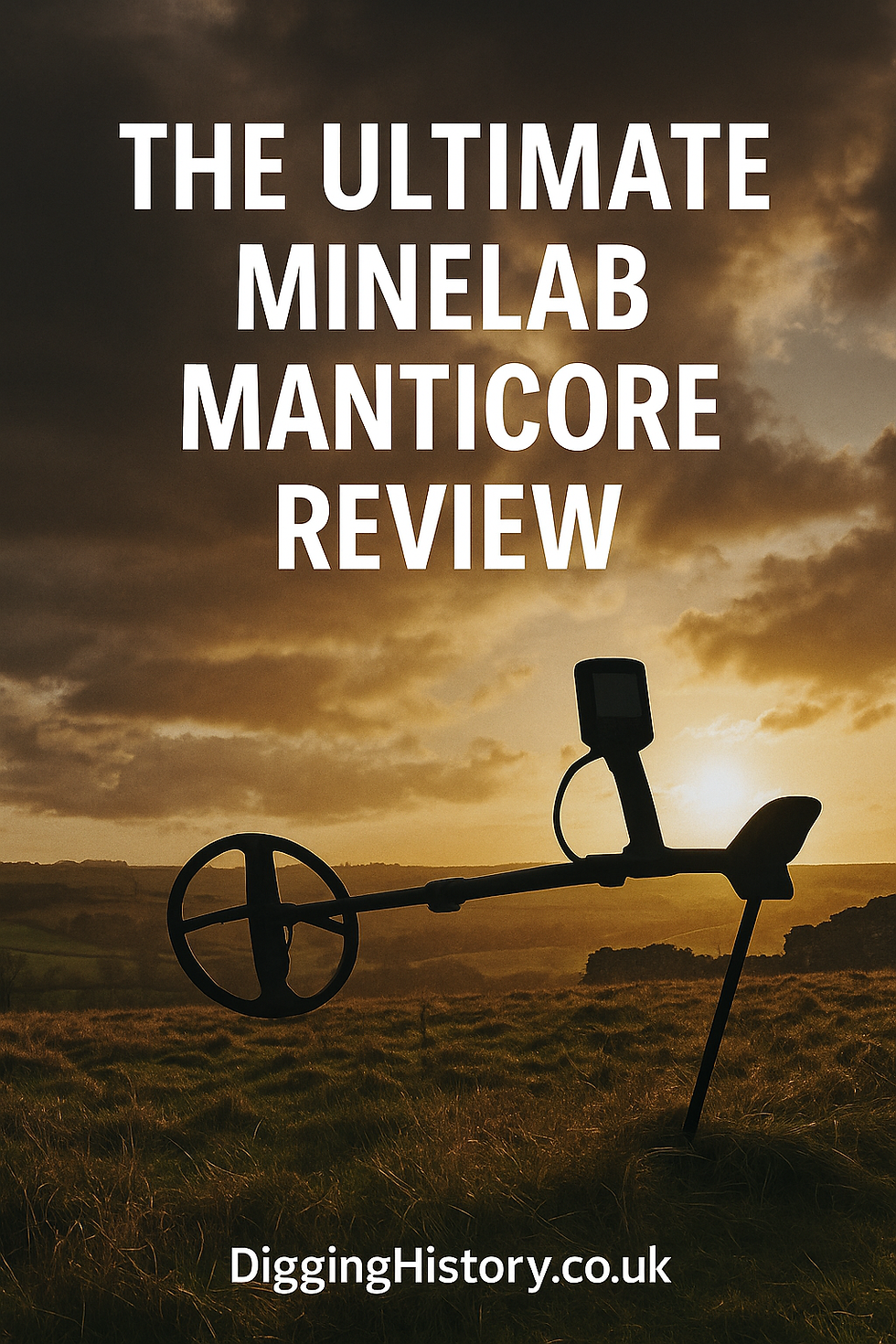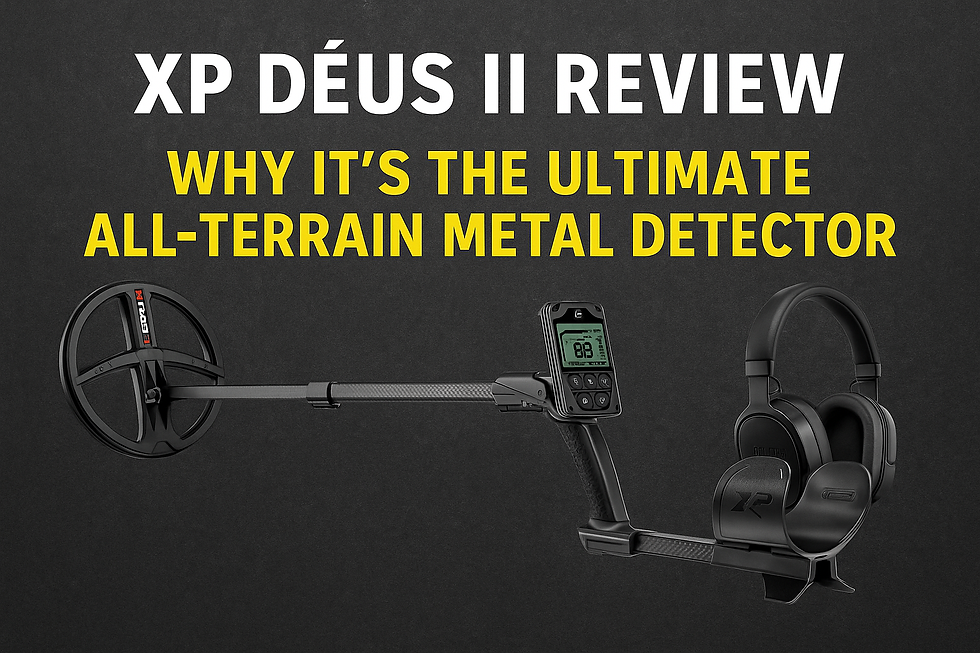Viking Treasure UK: Britain & Metal Detecting: The Ultimate Guide to Unearthing Treasure from AD 793–1066
- DiggingHistory.co.uk
- Sep 22
- 5 min read
Raiders, Traders, and Treasures Beneath Our Feet
In AD 793, monks at Lindisfarne recorded a terrifying sight: Viking longships on the horizon. What followed was two and a half centuries of raids, settlements, kingdoms, and cultural fusion that reshaped Britain until the Norman Conquest of 1066.
The Vikings were not only warriors, they were farmers, traders, craftsmen, and silver hoarders. They left behind arm-rings, coins, hacksilver, pendants, tools, and weapons, much of which still lies beneath Britain’s fields. For detectorists, Viking-era finds are some of the most dramatic and rewarding: a mix of raw bullion, battle gear, and exquisite craftsmanship.
This guide explores the Viking Age in Britain from a detectorist’s perspective: what they left, why so much survives, famous and lesser-known finds, where to search, and how to record responsibly under UK law.

Viking Britain at a Glance (AD 793–1066)
AD 793 – First recorded raid at Lindisfarne.
9th century – The “Great Heathen Army” lands; Viking control spreads.
Danelaw established – Eastern and northern England under Viking rule.
10th century – Anglo-Saxons reconquer much of England, but Viking presence remains.
11th century – Cnut the Great rules England as part of a North Sea empire.
1066 – Harald Hardrada defeated at Stamford Bridge; Norman conquest ends Viking age.
For detectorists, this timeline translates into: early raid losses, Danelaw hoards, Anglo-Viking artefacts, and late Scandinavian-style coinage.
Material Culture: What Vikings Left Behind
Hoards & Hacksilver
Vikings valued silver bullion as much as coins. They cut up jewellery and ingots into “hacksilver” to be weighed. Detectorists often encounter:
Arm-rings, whole or cut.
Neck rings and ingots.
Hacksilver fragments.
Large hoards often combine coins + hacksilver, buried for safekeeping during conflict.
Coins

Viking Britain saw a rich mix of coinage:
Anglo-Saxon pennies circulated alongside Viking issues.
Danish “St Edmund” coins (minted after Edmund’s martyrdom).
York mint produced Viking rulers’ coins (e.g. Cnut, Anlaf).
Arabic dirhams sometimes appear in Viking hoards, evidence of far-reaching trade.
Weapons

Though iron corrodes, detectorists sometimes find:
Axe heads (bearded axes typical).
Sword fittings and pommels.
Spearheads.
Shield bosses.
These are rare but highly significant.
Jewellery

Viking jewellery is distinctive:
Silver arm-rings with punched decoration.
Thor’s hammer pendants.
Beads of amber, glass, or semi-precious stones.
Christian crosses, showing conversion.
Tools & Everyday Items

The Vikings were practical people. Finds may include:
Keys and lock parts.
Weights used for silver bullion trade.
Farming tools (sickles, knives).
Gaming pieces (often of bone or antler).
Why Viking Artefacts Survive in UK Soil
Hoarding tradition – Silver buried for safekeeping, never recovered.
Warfare – Wealth concealed during invasions and raids.
Bullion economy – Hacksilver meant constant movement of cut items.
Settlement churn – Villages, farms, and markets saw steady losses.
Trade routes – River corridors and ports produced coin scatters and weights.
Famous Viking Detectorist Finds
1) Cuerdale Hoard (Lancashire, 1840, workers find, but still iconic)
The largest Viking treasure uk hoard in Britain: over 8,600 silver objects and coins. Buried c. AD 905, includes Anglo-Saxon, Frankish, and Arabic coins.
2) Vale of York Hoard (2007)
Discovered by detectorists David and Andrew Whelan near Harrogate. Contains 617 silver coins and 65 items of bullion, including a Carolingian silver vessel. Buried around AD 927.
3) Silverdale Hoard (Lancashire, 2011)
Found by detectorist Darren Webster: 200 silver coins and artefacts, including coins inscribed with the name “AIRDECONUT”, a previously unknown Viking king.
4) Bedale Hoard (North Yorkshire, 2012)
Detectorists uncovered a hoard of silver ingots, hacked-up arm-rings, and Anglo-Saxon sword fittings. Shows overlap between Viking and Saxon cultures.
5) Watlington Hoard (Oxfordshire, 2015)
Discovered by detectorist James Mather: 200+ coins, silver ingots, arm-rings. Dates to the late 870s during the struggle between Alfred the Great and the Viking Guthrum.
Lesser-Known Viking Finds
Isle of Man finds – numerous small hoards of silver arm-rings and coins.
Norfolk & Lincolnshire PAS reports – regular single finds of Viking pennies and beads.
Cumbria gaming pieces – carved bone playing counters linked to Viking settlements.
Yorkshire hack silver fragments – often overlooked but part of bigger bullion networks.
Detecting the Viking Landscape
The Danelaw
Eastern and northern England (Lincolnshire, Yorkshire, East Anglia) were under Viking control. Detectorists find coins, jewellery, and hacksilver here more often than elsewhere.
River Routes
Vikings followed rivers inland. Look near Ouse, Trent, Severn, and Thames valleys for trade-related finds.
Settlements
Farmsteads leave small scatters of weights, coins, and beads. Market sites may show clusters of coinage.
Battlefields
Sites like Tettenhall (AD 910) or Maldon (AD 991) are protected, but their hinterlands sometimes yield stray losses.
Recognising Viking Finds
Arm-rings: Wide silver bands, often cut.
Weights: Lead or bronze, sometimes decorated.
Coins: York-mint pennies, Danish St Edmund issues, Arabic dirhams.
Thor’s hammers: Small silver or bronze pendants.
Tools: Knives, sickles, weights, keys.
Gaming pieces: Rounded bone or antler discs.
Laws & Responsible Detecting
England, Wales & NI – Treasure Act 1996
2+ coins over 300 years old = Treasure.
Gold/silver artefacts over 300 years old = Treasure.
Must report to local FLO.
Scotland – Treasure Trove
All significant finds claimable by the Crown.
Report to Treasure Trove Unit.
Always:
Secure landowner permission.
Avoid scheduled monuments.
Record all finds with PAS or TTU.
What Viking Finds Teach Us
Cuerdale Hoard – political turmoil and Viking power bases in the north-west.
Vale of York Hoard – international trade links, from Russia to the Middle East.
Silverdale Hoard – reveals an unknown Viking king.
Watlington Hoard – shows Alfred the Great’s struggle with Viking leaders.
Bedale Hoard – cultural mixing of Viking and Saxon artefacts.
Practical Tips for Viking Detecting
Focus on Danelaw counties – Lincolnshire, Yorkshire, Norfolk, Suffolk.
Research river routes – Vikings used rivers like highways.
Look for hack silver – even tiny fragments tell a big story.
Weigh finds carefully – weights and bullion go hand in hand.
Don’t dismiss small items – beads, gaming pieces, and weights are diagnostic.
FAQs
Where are Viking finds most common in the UK? Eastern and northern England (the Danelaw) — especially Lincolnshire, Yorkshire, Norfolk, Suffolk.
What’s the most famous Viking hoard in Britain? The Cuerdale Hoard (8,600+ silver items), though recent detectorist finds like the Vale of York Hoard rival it.
Do Vikings always hoard silver? Yes — silver bullion was central to Viking wealth, but they also left behind jewellery, weapons, and tools.
Can I keep Viking coins or silver I find? If it qualifies as Treasure, you must report it. Even single finds should be recorded with PAS or TTU.
Viking Silver, Viking Stories, Viking Treasure UK
The Viking Age in Britain left treasures of both silver and story. From great hoards like Cuerdale and Vale of York, to humble gaming pieces or Thor’s hammer pendants, detectorists continue to uncover evidence of raiders, traders, and settlers.
Every Viking signal is a piece of that turbulent age, a reminder of ships on the horizon, markets buzzing with bullion, and warriors burying wealth they would never retrieve. Detect responsibly, record carefully, and you may help write the next chapter of Britain’s Viking history.
Thank You for Reading
Thank you for joining us on this journey into Viking Britain and the treasures it left behind. Every find, from a simple coin to a great silver hoard, helps bring this turbulent era back to life.
👉 If you found this guide useful, please share it with fellow detectorists, history lovers, and friends. The more we share knowledge, the stronger our community becomes and the richer our understanding of Britain’s past.





Comments